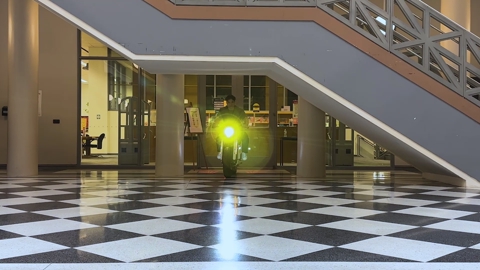
Illuminating Safety
Industrial design student pioneers award-winning motorcycle design protecting riders
by Stephen Schad • October 17, 2024
Motorcyclists face heightened risks, especially at night, due to their reduced visibility to other drivers. Project Legacy, an innovation in motorcycle safety, addresses this issue with advanced lighting and smart detection systems designed to make riders more visible and reduce accident risks. Developed by University of Houston Gerald D. Hines College of Architecture and Design alumnus Khanh Vu (B.S. ’24), an experienced rider who combined personal insights with thorough research, Project Legacy offers a bold solution to a pressing problem in the motorcycle world.
In spring 2024, Vu created Legacy as his senior capstone project under the director of industrial design (ID) co-directors Jeff Feng and Mark Kimbrough and associate instructional professor Adam Wells. Instructors challenged students to fashion a design exemplifying their education through research, innovation, and project development. Legacy took three and a half months to develop and a budget of approximately $9,000.
“This project was a personal journey that helped confirm my passion for industrial design and my capability to succeed in it,” shared Vu. “I initially joined the ID program in 2017 but dropped out after a semester because I was not sure it was the right fit. After taking a few gap years to explore different majors and career paths, I returned to the program with a renewed commitment and used this project to prove it was the right choice.”
Above: Vu's process included sketching, prototyping, research, and testing by collaborating with classmates
The standout feature of Legacy is its high-strength LED lights with diffusion filters, ensuring riders are visible without blinding other drivers. These lights, kept below 3000 lumens to comply with transportation codes, provide clean, bright illumination. Additionally, laser projection technology enhances rider safety by projecting red lines behind the motorcycle when braking, clearly signaling to surrounding drivers a clear indication of where to stop. Motorcycles can brake significantly faster than cars, so this new technology helps prevent rear-end collisions.
Legacy also integrates front and rear cameras into its design, offering riders real-time blind spot monitoring and situational awareness. These cameras, combined with the lighting system, provide continuous data to ensure safety in various traffic conditions. The smart infotainment system, sourced from Amazon, includes GPS, Bluetooth, Apple CarPlay, and Android Auto, giving riders a connected, seamless experience on the road.
Vu found inspiration from futuristic designs like those seen in Tron, desiring for Legacy’s sleek, cyber-style aesthetic to stand out in the electric motorcycle market. Using 3D CAD modeling and a full-scale 3D-printed prototype, Vu carefully tested and refined his design to prioritize style and function. Powered by a 72V motor, the bike went through rigorous user testing to ensure the LED lights did not blind drivers and the bike remained visible from various angles.
Above: renderings of the bike and its features; vu posing with his working design at the hines college
Legacy has already garnered industry attention, winning the DNA Paris Design Award in the Transportation sector and earning recognition as a finalist in the international SPARK Design Awards. Vu hopes to attract investors and bring the bike to production, making the necessary adjustments to comply with industry standards while maintaining its innovative safety features.
"Recognition from these awards shows that my design can address challenges that even major companies have yet to resolve, demonstrating innovation on a global scale,” said Vu. “They represent the hard work, creativity, and support from my friends and family, allowing me to achieve something unique as a student. This is just the beginning of my journey, and I will continue to improve and make a lasting impact on the community through meaningful design."
The Hines College’s industrial design program is no stranger to excellence in transportation design. In 2020, Josh Probst (B.S. ’19) won the DNA Paris Design Award for his innovative, customizable motorcycle design. In 2022, the Toyota Logistic Design Competition named Jacob Abraham (B.S. ’22) as the first-place winner for Oro, a delivery vehicle created for the transportation of valuable items in urban environments. Industrial design studios have also focused on racing wheelchairs, adaptive watercrafts, and electric vehicles.
Vu's Project Legacy sets a new standard for motorcycle safety, blending advanced technology, intelligent design, and rider-focused features to create a safer, more connected riding experience.
More College of Architecture and Design Stories

In architecture, learning never stops. The leap from theory to practice is essential for every architecture student, and internships are the key to making that transition. Eight Hines College students took these opportunities over the summer to immerse themselves in the industry, tackle real projects, form a professional network, and build up their skillset.

Hines College alum Paul Molina (B.S. ’19) received a Fulbright award to explore displacement in Mexico City caused by gentrification, using the Chicano aesthetic of rasquachismo. His project involves creating scenic installations to represent the cultural memories of displaced families.

Hines College alumni, faculty, and students secured six honors at the AIA Houston Design Awards, with projects ranging from built projects to conceptual work. These recognitions include innovative solutions, design for community, attention to sustainability, and contributions to the architectural landscape.





